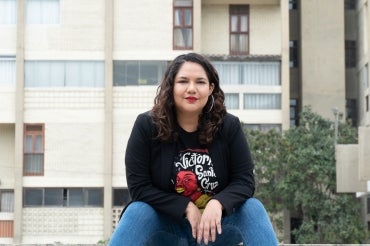PhD project explores how Afro-Peruvian women shaped Lima through music and performance

Roxana Escobar Ñañez traveled to Lima to interview Afro-Peruvian singers and performers as part of her dissertation (supplied image)
Published: December 14, 2023
Growing up in an Afro-Peruvian family in Peru’s capital Lima, Roxana Escobar Ñañez was always surrounded by music.
A PhD student in the department of geography & planning in the University of Toronto’s Faculty of Arts & Science, Escobar Ñañez says Lima’s cultural identity owes much to the songs and performances of Afro-Peruvian women since the early 1900s – but their contribution is often overlooked or reduced to showbusiness.
“Music as a staple of Afro-Peruvian identity, particularly in Lima, is something that I believe has been reduced to a stereotypical characteristic of the Black population of Peru,” says Escobar Ñañez, whose research explores the centrality of Afro-Peruvian women’s music and performance in Lima’s cultural identity.
“It’s not something that is seen as a way that we have constructed the nation and the development of urban life.”
Escobar Ñañez’s PhD dissertation spotlights criollo music, which is traditional to working-class neighbourhoods populated by people of Black, Indigenous, Japanese and European heritage.
As part of her research, she travelled to Lima to interview performers and document the role of Afro-Peruvian women singers and performers in shaping the city. Her project is supported by the 2022 Connaught PhDs for Public Impact Fellowship Program and the 2022 IDRC International Doctoral Research Award, which support doctoral students across Canada in pursuing international field work.
So far, Escobar Ñañez has interviewed 25 singers, the oldest being an 85-year-old performer still active in the circuit. She found that older performers act as gatekeepers of traditional criollo music, while the younger generation also taps into other genres like jazz, blues and salsa.
“The younger generation sing and dance differently… and turn to digital methods to make new sounds, whereas the older generation are very specific about what they sing and how,” says Escobar Ñañez, who is supervised by Associate Professors Tamara Walker of the department of history and Matthew Farrish of the department of geography & planning.
While criollo music was born in domestic spaces that characterized Afro-Peruvian life, it eventually made its way to the rest of Lima, says Escobar Ñañez, with immersive spaces to listen to criollo music – and some of the city’s world-renowned performers – remaining a core element in Lima’s tourism sector.
As she visited venues and house parties to study criollo music, Escobar Ñañez documented cultural experiences as well as conversations between musicians with memories and knowledge that dated back to the early 1900s.
While interviewees shared stories of encountering racism and misogyny, there was also widespread expression of pride in their work. “As Afro-Peruvian women, they carry the pride of the music,” Escobar Ñañez says.
Escobar Ñañez’s interviewees included performers like Marina Retto, the Lopez sisters and Rosita Guzman. Many consistently highlighted the importance of honouring the beauty and the complexity of seminal criollo performers like Felipe Pinglo Alva and Manuel Acosta Ojeda.
As part of her PhD research, Escobar Ñañez is producing a podcast using her interview material. The goal of the podcast – which is supported by the Graduate Fellowship Program in Critical Digital Humanities – is to preserve and celebrate Lima’s history by merging traditional practices like oral history with digital methods.
In addition to the contributions of Black women to the popularity of criollo music, Escobar Ñañez’s research also delves into where Black life is present in Lima and the role of Blackness in constructing the city.
She points out the Afro-Peruvian community shaped the city’s infrastructure through everyday activities as far back as the 1700s. “Lima relied on the urban infrastructure of Black bodies, which became time and space — from the Afro-Peruvian women walking through neighbourhoods in the morning and singing that they had bread and coffee to the last song at night saying it was time for bed,” Escobar Ñañez says.
“If you take away these activities, you wouldn’t have the urban life that we have now.”
Escobar Ñañez is now working on a paper about how to conduct field work involving Black women in Latin America – and the role that sound can play in the process.
“When we study populations that clearly demonstrate different ways of existing, including sounds and conversations is one way of research that I want to continue developing.”



